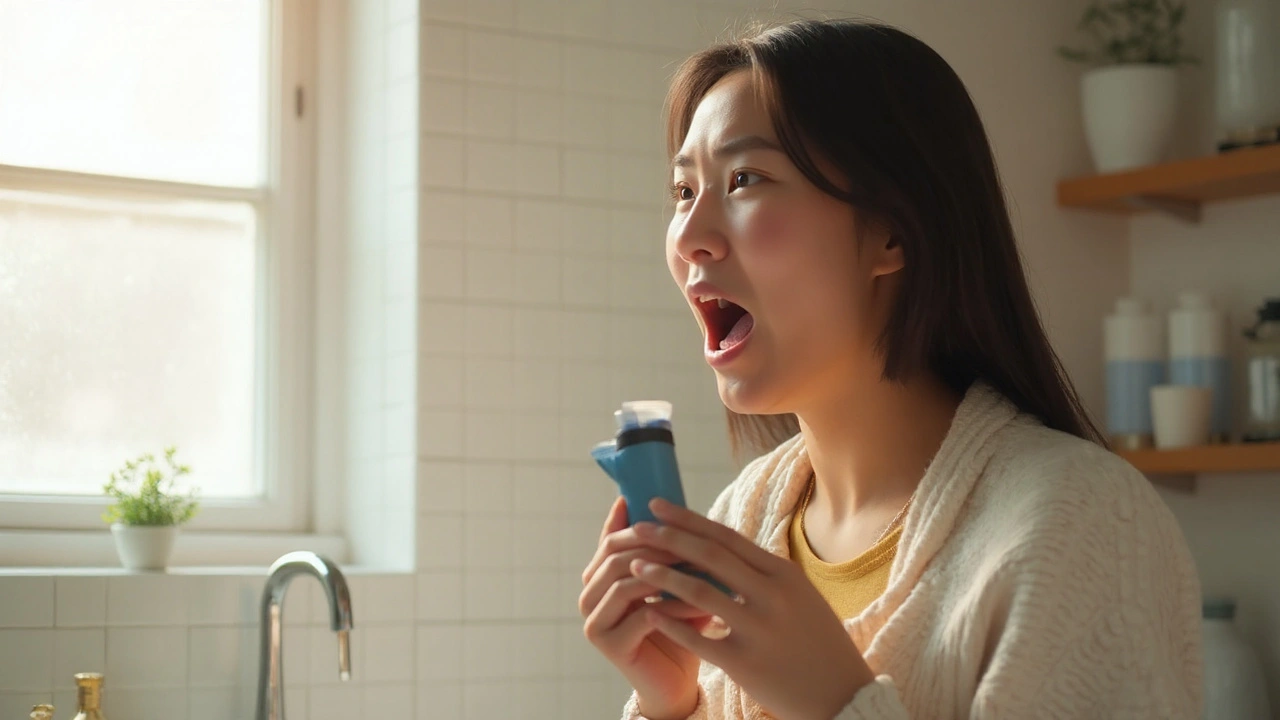Fluticasone Oral Health Risk Calculator
Fluticasone is a synthetic glucocorticoid classified as an inhaled corticosteroid (ICS) that reduces airway inflammation in conditions like asthma and allergic rhinitis. When you take it via a metered‑dose inhaler or a nasal spray, the drug lands not only in your lungs or nose but also on the lining of your mouth and throat, where it can trigger a cascade of oral side effects. Understanding those side effects is essential if you want a healthy smile while keeping your breathing under control.
How Fluticasone Works in the Respiratory Tract
The primary job of Fluticasone is to bind to glucocorticoid receptors on airway cells and shut down the production of inflammatory mediators such as cytokines and leukotrienes. This inhaled corticosteroid delivers a high local dose to the lungs while keeping systemic exposure low, which is why doctors favour it for long‑term asthma control. However, the same anti‑inflammatory power can dampen the mouth’s natural defence mechanisms.
Common Oral Side Effects Linked to Fluticasone
Patients most often report three problems after months of regular use:
- Oral thrush a fungal overgrowth of Candida species that appears as white patches on the tongue, palate or inner cheek.
- Gingivitis inflammation of the gum tissue that shows up as redness, swelling and bleeding on brushing.
- Dental caries cavities caused by acid‑producing bacteria thriving in a drier, less protected oral environment.
These issues are not unique to Fluticasone; any inhaled steroid can set the stage. What matters is how you manage the risk.
Why the Mouth Becomes a Breeding Ground
Three physiological changes explain the link between Fluticasone and oral problems:
- Reduced saliva flow Stimulatory effect of steroids on salivary glands can be suppressed, leading to a drier mouth (xerostomia). Saliva normally washes away food particles and buffers acids; when it drops, bacteria and fungi get a foothold.
- Local immunosuppression The anti‑inflammatory action of fluticasone dampens neutrophil and macrophage activity on the oral mucosa, allowing Candida to multiply unchecked.
- Residue deposition Improper inhaler technique leaves a thin film of drug on the tongue and palate after each puff. That film provides a nutrient‑rich surface for microbes.
Practical Steps to Protect Teeth and Gums
Good oral hygiene combined with a few habit tweaks can keep the side effects at bay:
- Rinse with plain water immediately after each inhaler use. The rinse physically removes drug residue before it settles.
- Consider a chlorhexidine antimicrobial mouthwash proven to reduce Candida and plaque levels once daily for two weeks after starting Fluticasone, then taper as symptoms improve.
- Brush twice a day with fluoride toothpaste and floss nightly. Fluoride strengthens enamel, making it harder for caries‑forming bacteria to attack.
- Stay hydrated. Sipping water throughout the day stimulates saliva production, counteracting xerostomia.
- Schedule dental check‑ups every six months. Your dentist can spot early signs of thrush or gingivitis and intervene quickly.
These habits are especially important during the first three months of therapy, when the oral environment is adjusting to the new medication.

Inhaler Technique Matters More Than You Think
Even the best oral‑care routine can be undermined by poor inhaler handling. Follow these tips:
- Shake the inhaler well before each use.
- Exhale fully, then place the mouthpiece between your teeth and lips, forming a tight seal.
- Press the canister once and inhale slowly and deeply over 3-5 seconds.
- Hold your breath for about 10 seconds to allow the drug to settle in the lungs.
- Spit out any excess medication and rinse with water.
Studies from the British Thoracic Society show that correct technique can reduce oral residue by up to 70%, directly cutting the risk of thrush and gum irritation.
Comparing Fluticasone with Another Common Inhaled Steroid
| Drug | Class | Typical Daily Dose (µg) | Oral Side‑Effect Risk | Recommended Oral‑Care Measures |
|---|---|---|---|---|
| Fluticasone | Inhaled corticosteroid | 100‑500 | Medium (thrush≈12%, gingivitis≈8%) | Water rinse, chlorhexidine 2weeks, fluoride toothpaste |
| Budesonide | Inhaled corticosteroid | 200‑800 | Low‑Medium (thrush≈8%, gingivitis≈5%) | Water rinse, regular floss, consider probiotic mouth rinse |
Both drugs share the same mechanism, but subtle formulation differences give Budesonide a slightly milder impact on the mouth. If you’ve struggled with oral thrush on Fluticasone, discuss a switch with your clinician-just don’t stop the medication abruptly.
Related Concepts Worth Exploring
Fluticasone sits inside a broader therapeutic landscape. Understanding the surrounding topics helps you make informed choices:
- Asthma management - the overall plan that includes rescue inhalers, long‑acting bronchodilators, and action plans.
- Allergic rhinitis - the nasal counterpart where Fluticasone nasal spray is often prescribed.
- Systemic corticosteroids - oral or injectable steroids that affect the whole body and carry a higher risk of oral side effects.
- Dental health - regular scaling, polishing, and fluoride applications that protect against the caries‑boosting effect of dry mouth.
- Probiotic oral care - emerging research suggests that beneficial bacteria can outcompete Candida, offering another layer of protection.
Each of these areas can be a next step for deeper reading, especially if you’re tailoring a personalized health routine.
When to Seek Professional Help
If you notice any of the following, book an appointment promptly:
- White patches that don’t wipe away - could be oral thrush.
- Bleeding gums or persistent bad breath - signs of gingivitis.
- Sharp tooth pain, especially after sweets - early cavity.
- Persistent dry mouth despite water intake - may need saliva substitutes.
Early intervention prevents the need for more aggressive treatments like antifungal medication or deep‑clean dental procedures.
Frequently Asked Questions
Can Fluticasone cause permanent damage to my teeth?
No. The drug itself does not erode enamel. Problems arise only when side effects like dry mouth or thrush go untreated. Good oral hygiene and regular dental visits keep the risk low.
Is it safe to use a fluoride mouthwash with Fluticasone?
Absolutely. Fluoride protects enamel and does not interfere with the steroid’s action. In fact, many dentists recommend a fluoride rinse after inhaler use.
How long should I rinse after each inhaler puff?
A quick sip of water followed by a gentle swish for 10-15 seconds is enough. Spit it out; you don’t need to swallow.
Can I switch to Budesonide if I keep getting thrush?
Yes, many clinicians consider Budesonide as an alternative because its oral‑side‑effect profile is slightly milder. Always discuss the change with your prescriber first.
Is a probiotic lozenge effective against oral thrush?
Early trials show promise, especially strains likeLactobacillus reuteri, which can compete with Candida. They’re a useful adjunct but shouldn’t replace a proper antifungal if an infection is established.
Do I need to stop Fluticasone before dental work?
Generally no. The systemic dose is low, and stopping could worsen asthma control. Inform your dentist, who may advise a short‑term antimicrobial mouth rinse after the procedure.
By combining proper inhaler technique, diligent oral hygiene, and regular dental check‑ups, you can enjoy the breathing benefits of Fluticasone without compromising your smile. Remember, the key is consistency - a quick water rinse after each puff and a thoughtful daily routine go a long way toward preserving Fluticasone oral health.


6 Comments
September 23, 2025 Marjory Beatriz Barbosa Honório
Wow, I never realized how a simple inhaler could have such a ripple effect on our smiles and gums. It's eye‑opening to see the connection between daily dose and dental health, especially when you factor in technique. Rinsing properly after each use can really be a game‑changer, so let's all remember to give our mouths a good swish. If you’ve got any tips on making the rinse habit stick, feel free to share – we’re all in this together!
September 23, 2025 G.Pritiranjan Das
Good reminder to rinse after each inhaler use.
September 23, 2025 Karen Wolsey
Oh great, another reminder that my asthma meds might be ruining my perfect dentist‑approved smile. As if battling wheezing wasn’t enough, now I have to worry about plaque building up like it’s auditioning for a horror movie. Maybe the next breakthrough will be a floss‑infused inhaler – now that would be cutting‑edge.
September 23, 2025 Melissa H.
Fluticasone’s pharmacodynamics involve local immunosuppression in the airway mucosa, which can unintentionally lower the oral cavity's microbial defenses. When the medication deposits on the oropharyngeal epithelium, it creates a microenvironment conducive to fungal overgrowth, especially Candida species, leading to oral thrush if not mitigated. Moreover, the corticosteroid's anti‑inflammatory action can dull the natural inflammatory signals that alert us to early gum irritation, allowing periodontal disease to progress under the radar. The dosage matters: higher micro‑gram loads increase the residual volume that can coat teeth and gums, intensifying the risk. Duration compounds the effect-prolonged use without adequate oral hygiene can shift the oral microbiome equilibrium, favoring pathogenic bacteria over commensals. Inhaler technique is a critical variable: suboptimal mouth‑to‑lung coordination often results in oropharyngeal deposition instead of lower‑airway delivery. A “good” technique, complemented by a thorough rinse with water or an antimicrobial mouthwash, can remove up to 80 % of residual particles. Conversely, a “poor” technique leaves a substantial amount of drug in the oral cavity, dramatically raising the odds of enamel demineralization and gingival inflammation. The calculus calculator in the article cleverly integrates these parameters-dose, duration, and technique-to provide a personalized risk score, which can guide clinicians in counseling patients. For patients who struggle with rinsing, clinicians might consider prescribing a spacer device, which helps divert aerosolized particles away from the mouth. Additionally, scheduling regular dental check‑ups every six months becomes even more crucial for early detection of any adverse changes. Some studies suggest that incorporating a fluoride rinse post‑inhaler can counteract enamel softening, though the evidence is still emerging. It's also worth noting that smoking exacerbates these risks, as tobacco residues further impair mucosal immunity. Patients should be encouraged to quit smoking and maintain optimal oral hygiene practices, including brushing twice daily with a soft‑bristled brush and flossing. Ultimately, awareness is the first line of defense: understanding how an asthma medication intersects with oral health empowers patients to take proactive steps, preserving both respiratory and dental wellbeing.
September 23, 2025 Edmond Abdou
Great breakdown! 👍 Rinsing and maybe a spacer sound like simple fixes that could save a lot of hassle later.
September 23, 2025 Sydnie Baker
While the preceding exposition admirably enumerates the iatrogenic sequelae of inhaled glucocorticoids, it neglects to invoke the nuanced stratigraphy of salivary pH modulation-a variable of paramount salivary biochemistry. One must also contend with the proteolytic cascades engendered by persistent corticosteroid exposure, which inexorably precipitate dentin‑enamel interface compromise. In sum, a multidisciplinary approach, integrating periodontological prophylaxis and pharmaco‑kinetic vigilance, is the only intellectually defensible paradigm.
Write a comment